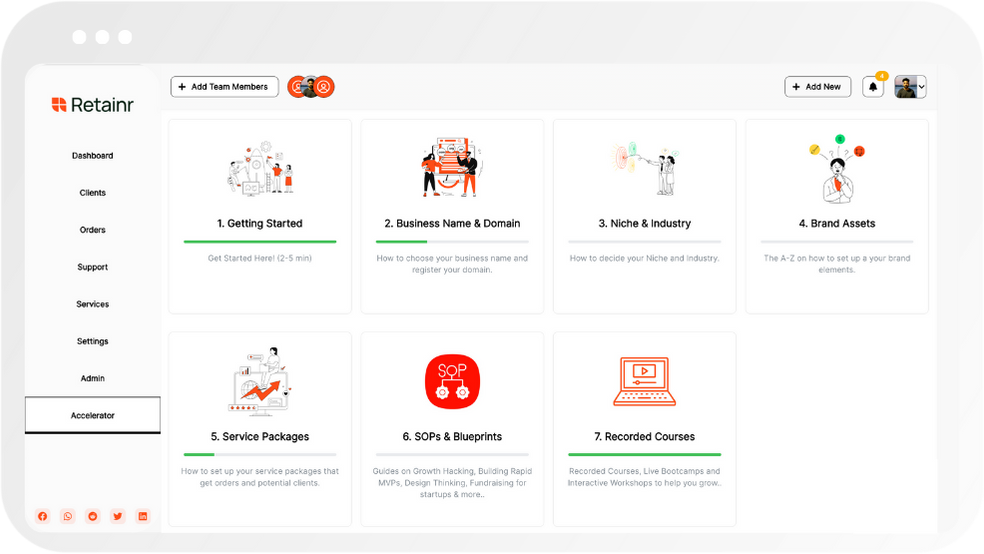
6 Tips For Better Communication With Remote Teams
Build with Retainr
Sell your products and services, manage clients, orders, payments, automate your client onboarding and management with your own branded web application.
Get Started1. What are six tips to improve communication with remote teams?
Key Tips for Enhancing Remote Team Communication
In the age of remote work, effective communication with your team is more crucial than ever. Here are six tips to enhance your communication efforts:
- Use the Right Tools: Digital collaboration tools like Slack, Microsoft Teams, or Asana, can enhance communication and keep everyone on the same page.
- Be Clear and Concise: When working remotely, clear and concise communication can save time and prevent misunderstandings.
- Set Expectations: Be clear about what each team member is responsible for and set realistic deadlines.
- Encourage Open Communication: Team members should feel comfortable sharing their ideas, feedback, and concerns. An open communication culture leads to a more engaged and productive team.
- Regular Check-ins: Regular meetings or check-ins can help ensure that everyone is working towards the same goals.
- Provide Feedback: Providing constructive feedback helps team members understand how they are doing and how they can improve.
Comparing Communication Tools
Not all communication tools are created equal. Here is a simple comparison table to help you understand the different options:
| Tools | Strengths | Weaknesses |
|---|---|---|
| Slack | Real-time communication, easy file sharing, integrates with other tools | May become overwhelming with too many channels |
| Microsoft Teams | Integrates with Office 365, allows for video conferencing | Certain features only available with paid version |
| Asana | Great for project management, allows for task assignment and tracking | Not ideal for real-time communication |
2. How can team leaders better communicate with remote teams?
Utilize Appropriate Communication Tools
Team leaders need to utilize technological tools to create a seamless communication pathway between their team members. Here are a few vital tools that can be employed:
- Task Management Software: Apps like Trello or Asana help organize tasks and track project progression for each team member.
- Video Conferencing Tools: With tools like Zoom or Skype, leaders can conduct team meetings that allow for better interactive communication.
- Instant Messaging Platforms: Tools such as Slack, Teams or Hangouts can ensure the fast and efficient delivery of updates and information.
Establish Clear Communication Norms
Leaders must set clear guidelines and expectations regarding communication. These rules can be about response times, availability, preferred communication channels, frequency of updates etc. This will minimize ambiguity and facilitate better understanding between team members. Here is a sample communication norm table:
| Communication Type | Tools to Use | Expected Response Time |
|---|---|---|
| Outlook, Gmail | Within 24 hours | |
| Instant Messaging | Slack, Teams | Within 1 hour during work hours |
| Video Call | Zoom, Skype | Scheduled in advance |
Promote Open and Inclusive Communication
Leaders should foster a culture of open communication where every team member is free to voice their opinions and ideas. This can be achieved by:
- Encouraging active participation: Team leaders should actively include every member in discussions and decision-making processes.
- Asking for feedback: Leaders should proactively seek input and ideas from their team members about key projects and decisions.
- Establishing a 'No Blame' culture: Ensuring that the team environment is safe for expressing different opinions without the fear of retribution or blame.
3. Why is effective communication important in remote teams?
Importance of Effective Communication in Remote Teams
Successful remote teamwork largely depends on effective communication. In traditional office settings, miscommunication can be quickly resolved through face-to-face interactions. However, in remote teams, miscommunications can easily lead to project delays, confusion, and reduced productivity. Effectively communicating ensures everyone is on the same page and improves the overall efficiency of the team.
- Saves time: Clear and concise communication minimizes the need for constant clarifications and repeat discussions.
- Promotes transparency: With effective communication, all team members have a clear understanding of their roles, the project timeline, expectations, and the status of the work.
- Boosts morale: Open and ongoing communication makes team members feel connected, appreciated, and involved in decision-making processes, thereby increasing job satisfaction.
A Deeper Look: The Impact of Communication on Remote Teams
To further illustrate the importance of effective communication in remote teams, here's a table showing some potential problems and their corresponding solutions:
| Potential Problems | Solutions |
|---|---|
| Misunderstanding of tasks | Clear, concise instructions and frequent check-ins |
| Inefficient use of time and resources | Precise communication of goals, expectations, deadlines, and individual responsibilities |
| Feelings of isolation | Regular team meetings and one-on-one sessions |
| Low morale and lack of motivation | Open lines of communication, positive feedback, and recognition of good work |
4. Can you suggest some tools or platforms to better communicate with remote teams?
Communication Tools for Remote Teams
Many businesses globally are adapting to remote work, and with that transition comes the need for effective communication tools. Here are a few that have proven beneficial for seamless interaction within remote teams:
- Slack: Slack facilitates instant messaging in an organized manner, providing an easy way to quickly interact with different team members simultaneously.
- Microsoft Teams: This is coined as a unified communication and collaboration platform which combines persistent workplace chat, video meetings, file storage and application integration. Additionally, it comes equipped with plenty of useful features such as screen sharing and document collaboration.
- Zoom: Zoom is popular for virtual meetings because of its user-friendly interface and superior video/audio quality.
- Google Hangouts: An excellent tool for instant messaging and video calls. Google Hangouts allow for brainstorming and quick catch-ups seamlessly on-the-go.
- Asana: A web and mobile application designed to help teams organize, track, and manage their work, thereby ensuring everyone is on board with a project’s progress.
- Trello: Trello is a visual tool for organizing your work and life into boards. Here, tasks are represented by cards, which can be moved between categories.
How to Choose the Right Platform
Selecting the right platform plays a significant role in ensuring effective communication among remote teams. A few factors to consider are:
| Factors | Why It Matters |
|---|---|
| Usability | A tool should be user-friendly and not require a steep learning curve to ensure all team members can use it effectively. |
| Integration | Platform should be capable of integrating with other tools you already use for easy assimilation within your team's workflow. |
| Scalability | As your team expands, the tool should be scalable and capable of handling the increased load effortlessly. |
| Cost-Effectiveness | The tool should be cost-effective and provide value for money, considering its features, accessibility and efficiency. |
5. How can companies foster a culture of open communication in remote work environments?
Fostering a Culture of Open Communication
Obtaining open and consistent communication in a remote work environment can be a challenge. However, companies can adopt several strategies to promote open communication. Firstly, they can utilize different communication tools such as instant chat, video conferencing and email to cater to different communication preferences. Secondly, they should train managers and team leaders to encourage feedback and interaction in online meetings. Lastly, they can establish a regular communication routine, so everyone knows when and how they are expected to communicate.
One of the key ways to encourage open conversations is to make sure everyone has the appropriate tools and knows how to use them. Below is a table listing some of the most popular communication tools and their purposes:
| Tool | Purpose |
|---|---|
| Zoom | Video conferences and meetings |
| Slack | Instant chat for quick questions and team discussions |
| Formal communication and updates |
Furthermore, managers and team leaders can foster open communication by being accessible and responsive. They can assure their team members that it is safe to voice their thoughts, ideas, and concerns. Creating an environment in which employees feel respected and valued will promote open conversation. Companies could introduce guidelines detailing the code of conduct during online meetings. For instance, respecting everyone's time by keeping to the schedule and demonstrating active listening. Finally, establishing a regular communication routine, such as weekly meetings or daily stand-ups, will help maintain clear communication channels.
6. How do the six tips for better communication help in improving the overall productivity of remote teams?
Enhancing Productivity Through Effective Communication
Improved communication with remote teams, facilitated by these six tips, can significantly enhance overall productivity. Firstly, it promotes more efficient operations by reducing misunderstandings, thereby minimizing work delays caused by fixable communication-related mishaps. Secondly, superior communication fosters more cooperative teamwork and leads to a faster decision-making process, accelerating the completion of projects. Lastly, fruitful communication generates a sense of community, boosting morale and employee satisfaction, which directly influences a team's productivity levels.
Benefits of Effective Communication to Productivity
- Minimizes Misunderstandings: By fostering clear, concise, and consistent communication, the chances of miscommunication are substantially reduced. This decreases the amount of time spent solving these mishaps, leading to more efficient operations and higher productivity.
- Faster Decision Making: Superior communication enables team members to understand the project's goals and their roles more clearly. This clarity helps in making decisions faster, accelerating the project completion and thus boosting productivity.
- Boosts morale and Satisfaction: Regular and constructive communication helps team members feel valued and included, boosting morale. Higher employee morale and satisfaction directly influence enhanced productivity levels.
Breakdown of the Impact of Improved Communication on Remote Team Productivity
| Communication Improvement | Impact on Productivity |
|---|---|
| Minimizing misunderstandings | More efficient operations |
| Faster decision making | Rapid project completion |
| Boosting morale and satisfaction | Improved output levels |
7. In what ways can managers enhance their skills for communicating with remote teams?
Develop a Clear Communication Strategy
Developing a clear communication strategy is a central aspect of managing remote teams. Managers should:
- Clearly define work expectations to avoid misunderstandings.
- Use the right tools and platforms, like Slack, Microsoft Teams or Zoom, that suit their team's communication needs.
- Regularly update the team about changes in the organization, project updates, new initiatives, etc.
- Include all team members in the communication loop to prevent them from feeling isolated.
Improve Active Listening Skills
Active listening is crucial for effective communication. It ensures that managers fully understand their team members' ideas, thoughts, and concerns. Here is how managers can improve their active listening skills:
| Technique | Tips |
|---|---|
| Showing Empathy | Try to understand the team member's perspective. |
| Non-verbal cues | Use nodding or brief verbal affirmations to indicate understanding. |
| Paraphrasing | Rephrase the speaker's words to confirm understanding. |
| Asking Questions | Ask open-ended questions to encourage further explanation. |
Provide Regular Feedback
Giving regular feedback can strengthen the communication between managers and their remote teams. It helps teams know where they stand, what they're doing well, and where they can improve. Tips for providing effective feedback include:
- Ensure that feedback is present, actionable, and specific.
- Try to balance the positive with the negative to avoid demotivating your team.
- When delivering negative feedback, be constructive and provide suggestions for improvement.
- Consider using a feedback tool to streamline the feedback process.
8. Can these communication tips be included in the training modules for remote team members for better understanding?
Incorporating Communication Tips into Training Modules
Enhancing remote communication skills among team members can be effectively done by embedding these communication tips into your training modules. This integration not only empowers your team with essential communication skills but also serves as an ongoing reference for best practices in the future. Below are ways on how to include these communication tips in training modules:
- Interactive Teamwork Exercises: Carry out interactive exercises such as role-plays and communication ice breakers. Such simulations allow participants to understand the importance and effectiveness of clear communication.
- Communication Manual: Create a communication manual with all the necessary guidelines and tips. Include it as a resource material during training sessions.
- Videos and Webinars: Visual aids like videos or webinars can be helpful to demonstrate communication processes with real-time scenarios. This aids in a better understanding.
Design of a Training Module
A systematic structure is essential while designing these training modules. The table below outlines a suggested format to include these communication tips efficiently into your training modules.
| Module Sections | Contents |
|---|---|
| Introduction | Explanation of the significance of effective communication in remote settings. |
| Interactive Exercises | Implementation of practical activities focusing on enhancing communication skills. |
| Instructional Material | Presentation of the communication guidebook with tips and strategies. |
| Videos/Webinar | Demonstration of effective communication through recorded videos or live webinars. |
| Conclusion | Final roundup by emphasizing the tips and encouraging their use in real-time communication. |
Benefits of Incorporating Communication Tips into Training Modules
Including communication tips into training modules not only helps in understanding but also instills a sense of clarity. Here's how such an approach can benefit:
- Enhanced Collaboration: Good communication is fundamental for effective collaboration in a remote setup. Learning these communication tips can help establish a robust remote work culture.
- Fewer Misunderstandings: Misunderstandings and miscommunications are minimized when the team is well-equipped with effective communication skills.
- Productive Work Environment: These modules can contribute significantly in creating a productive work environment that encourages open and clear communication.
9. How can these tips be implemented when there are language and time-zone differences among remote team members?
Implementation of Communication Tips amidst Language and Time-Zone Differences
Good communication is key, not just for on-site teams, but for remote teams more so where language or timezone differences could pose substantial challenges. The tips discussed here can be implemented thoughtfully to overcome these hurdles.
Addressing Language Barriers
Addressing language barriers in a multilingual remote team is paramount. Here's how:
- Use Language Translation Softwares: Tools such as Google Translate or Deepl can assist in translating messages relatively accurately if team members are not fluent in the common language.
- Encourage Learning: While translation tools are handy, it is not a replacement for human communication. Encourage team members to learn the common language better to avoid any miscommunication.
- Hire a Translator: For important meetings where miscommunication cannot be afforded, hiring a professional translator could be considered.
Overcoming Time-Zone Differences
Coordination across different time zones efficiently can strengthen the unity of the team. Here’s how one could manage the same:
| Tip | Implementation |
|---|---|
| Plan Meetings in Advance | Set a pre-determined schedule for meetings adjusting as much as possible for all time zones. |
| Use Scheduling Tools | Calendar tools can show the preferred time of all team members to find a common meeting time. |
| Embrace Asynchronous Communication | For tasks that do not require immediate attention, asynchronous communication methods should be encouraged. Emails, chat tools, project management softwares are examples of such ways. |
10. What are some creative ways to ensure clear and effective communication within remote teams?
Creative Strategies for Ensuring Clear and Effective Communication
Effective communication in remote teams is essential to keep everyone aligned on tasks and projects. Here are some inventive approaches you can adopt:
- Use Visual Aids: Providing charts, diagrams, or infographics can help to simplify complex ideas. Tools like Canva allow you to create effective visuals.
- Host Virtual Team-Building Activities: Activities like virtual happy hours, online games, or web-based quizzes can help to boost morale and encourage communication.
- Set Up Daily Stand-up Meetings: A short, daily meeting can enable each team member to discuss what they’re working on, flag any issues, and connect with the team.
- Encourage Video Calls: Face-to-face interaction, even through a screen, can often be more efficient and personal than an email or instant message.
Tools for Clear Communication in Remote Teams
There are numerous communication and project management tools designed for remote teams. Here's a table featuring a handful of the most popular ones:
| Tool | Purpose |
|---|---|
| Zoom | Video conferencing, meetings, webinars |
| Slack | Instant messaging, collaboration |
| Trello | Project management, task tracking |
| Google Docs | Document creation, real-time collaboration |
Importance of Clear Expectations
Setting clear expectations is another effective strategy for fostering clear communication in remote teams. This includes:
- Define Specific Deadlines: Clearly stating when tasks or projects should be completed helps to eliminate confusion.
- Set Communication Expectations: Let your team know when and how they should reach out to one another. This might involve specifiying preferable communication channels for different queries or issues.
- Clarify Roles and Responsibilities: Make sure each team member understands their role within the team and who to go to with specific concerns.
Conclusion
Tips for Effective Remote Team Communication
Efficient and clear communication is quintessential for managing remote teams effectively. Below are six crucial tips to enhance communication with remote teams.
1. Set Clear Communication Norms
It's essential to establish and communicate precise guidelines about response times, preferred communication tools, and the etiquette to follow during online interactions.
2. Leverage the Right Technology
Ensure that your team has access to modern communication and collaboration tools like Retainr.io, a white-label software designed specifically to manage clients, orders, and payments seamlessly.
3. Encourage Regular Check-ins and Updates
Regularly checking in with your team members not only shows your interest in their work but also gives you a better understanding of their progress and challenges.
4. Promote Real-time Communication
Immediate, real-time communication can improve the quality of teamwork by ensuring that everyone is on the same page and any issues are addressed rapidly.
5. Make Meetings More Organized
Pre-planned and well-organized meetings create an environment where each team member is more likely to be engaged and involved.
6. Cultivate an Open Communication Culture
An open communication policy encourages your team members to voice opinions, share ideas, and discuss potential challenges openly.
In the world of remote work, efficient communication is vital. By utilizing tools like Retainr.io, you can simplify the process of managing clients, orders, and payments, enhancing your team's productivity and communication. Try Retainr.io now to experience an effective way of streamlining your remote team communication and operations.
Boost Your Agency Growth
with Retainr Accelerator
Uncover secrets, strategies, and exclusive blueprints to take your agency's growth to the next level — from marketing insights to effective presentations and leveraging technology.

SOPs, Cheatsheets & Blueprints
Leverage 50+ SOPs (valued over $10K) offering practical guides, scripts, tools, hacks, templates, and cheat sheets to fast-track your startup's growth.
Connect with fellow entrepreneurs, share experiences, and get expert insights within our exclusive Facebook community.
.jpg)

Join a thriving community of growth hackers. Network, collaborate, and learn from like-minded entrepreneurs on a lifelong journey to success.

Gain expertise with recorded Courses, Live Bootcamps and interactive Workshops on topics like growth hacking, copywriting, no-code funnel building, performance marketing and more, taught by seasoned coaches & industry experts.

.jpg)

.jpeg)


